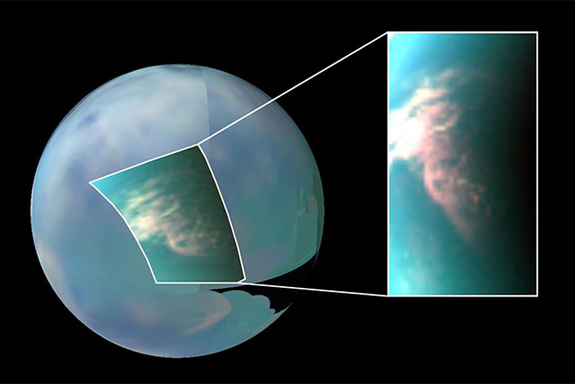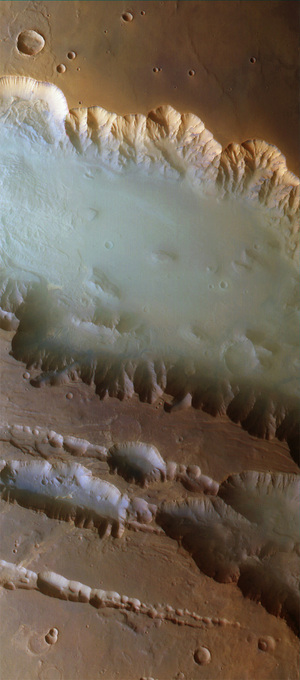
A 2009 paper first described fog at the south pole of Titan. This image shows where the fog was located based on data from the Cassini spacecraft.
Credit: Mike Brown/Caltech
More evidence has emerged, so to speak, of fog over a very special place: Titan. Titan is one of the largest moons in the solar system and is full of hydrocarbons, making it an interesting Saturn moon that looks like a precursor to what Earth was billions of years ago.
PHOTOS: 10 Years Later: When Huygens Landed on Titan
After multiple pictures of fog from Mars were released, the research team behind this new work wanted to know if it was possible to find fog using Huygens. Huygens was the European Space Agency’s lander, attached to NASA’s Cassini probe, that briefly survived on the surface of Titan in 2005.
“Ground fog on Titan has been seen before from orbit (Brown et al. 2009) so it’s not unexpected to find fog on the surface,” wrote York University postdoctoral researcher Christina Smith, the lead author of the study, in an email to Discovery News. “But it hadn’t been detected from the surface before, which is what we did in our research and why it’s exciting.”

Titan has very active weather, as shown by this infrared image of clouds near the south pole. Image taken by the Cassini spacecraft.
Credit: NASA/JPL/University of Arizona/University of Nantes
PHOTOS: Where in the Solar System is it Possible for Alien Life?
The work came from analyzing Huygens’ “side-looking imager” data after the craft had landed. They noticed that some of the image frames had linear features, compared with the average data found in most frames.

Mars is also known to have fog. This image of haze over Valles Marineris was taken by ESA Mars Express.
Credit: ESA/G. Neukum (Freie Universitaet, Berlin, Germany)/Bill Dunford
“We evaluated possible origins. Clouds were considered, but no consistent movement across the frame was detected, so this is unlikely,” Smith wrote. “A superior mirage was considered, but there was no temperature inversion detected on descent so again, this is considered unlikely. We considered a background rise, but due to several considerations our most likely explanation (in our opinions) is that this feature is due to a fog bank rising and falling.”
NEWS: Winter Is Coming: Giant Ice Cloud Appears On Titan
Fog was first recorded on this moon in 2009. At the time, California Institute of Technology co-discoverer Mike Brown said fog must have happened because of high humidity; in other words, it had rained. Cold air is uncommon on Titan — although it likely can cool somewhat above a pool of evaporating methane — and there are no mountains high enough on the surface for fog.
“Evaporating methane means it must have rained,” Brown wrote on his blog at the time . “Rain means streams and pools and erosion and geology. Fog means that Titan has a currently active methane hydrological cycle doing who knows what on Titan.”
NEWS: Titan Appears Earth-Like in New Image
But this fog forms differently from Earth, both Brown and Smith point out. The Titan fog is methane and happens when liquid methane on the surface evaporates. On Earth, fog occurs when air cools to the dew point.
The new research was published in the journal Icarus.
Originally published on Discovery News .
Comments are closed.